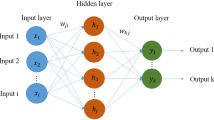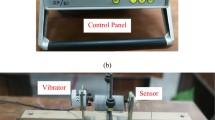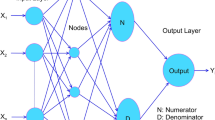In this paper, comparative evaluation of various local and global learning algorithms in neural network modeling was performed for ore grade estimation in three deposits: gold, bauxite, and iron ore. Four local learning algorithms, standard back-propagation, back-propagation with momentum, quickprop back-propagation, and Levenberg–Marquardt back-propagation, along with two global learning algorithms, NOVEL and simulated annealing, were investigated for this purpose. The study results revealed that no benefit was achieved using global learning algorithms over local learning algorithms. The reasons for showing equivalent performance of global and local learning algorithms was the smooth error surface of neural network training for these specific case studies. However, a separate exercise involving local and global learning algorithms on a nonlinear multimodal optimization of a Rastrigin function, containing many local minima, clearly demonstrated the superior performance of global learning algorithms over local learning algorithms. Although no benefit was found by using global learning algorithms of neural network training for these specific case studies, as a safeguard against getting trapped in local minima, it is better to apply global learning algorithms in neural network training since many real-life applications of neural network modeling show local minima problems in error surface.
Similar content being viewed by others

REFERENCES
Bishop, C. M., 1995, Neural networks for pattern recognition: Clarendon Press, Oxford, 482 p.
Gallagher, M. R., 1999, Multi-layer perceptron error surfaces: Visualization, structure and modeling: Unpublished PhD dissertation, University of Queensland, 225 p.
Hagan, M. T., Demuth, H. B., and Beale, M., 1996, Neural network design: PWS Publishing Company, Boston, 19 chapters.
Haykins, S., 1999, Neural networks: A comprehensive foundation, 2nd ed: Prentice Hall, New Jersey, 824 p.
Ke, J., 2002, Neural network modeling of placer ore grade spatial variability: Unpublished Doctoral Dissertation, University of Alaska Fairbanks, 251 p.
Kirkpatrick, S., Gerlatt, C. D., Jr., and Vecchi, M. P., 1983, Optimization by simulated annealing: Science, 220, p. 671–680.
Koike, K., and Matsuda, S., 2003, Characterizing content distributions of impurities in A limestone mine using a feed forward neural network: Nat. Resour. Res., v. 12, no. 3, p. 209–223.
Koike, K., Matsuda, S., and Gu, B., 2001, Evaluation of interpolation accuracy of neural kriging with application to temperature-distribution analysis: Math. Geol., 33, no. 4, p. 421–448.
Koike, K., Matsuda, S., Suzuki, T., and Ohmi, M., 2002, Neural network-based estimation of principal metal contents in the Hokuroku district, Northern Japan, for exploring Kuroko-type deposits: Nat. Resour. Res., v. 11, no. 2, p. 135–156.
Metropolis, N., Rosenbluth, A. W., Rosenbluth, M. N., Teller, A. H., and Teller, E., 1958, Equations of state calculations by fast computing machines: J. Chem. Phys., v. 21, p.1087–1092.
Pincus, M., 1970, A Monte Carlo method for the approximate solution of certain types of constrained optimization problems, Oper. Res., v. 18, p. 1225–1228.
Rizzo, D. M., and Dougherty, D. E., 1994, Characterization of aquifer properties using artificial neural networks: Neural kriging: Water Resour. Res., v. 30, no. 2, p. 483–497.
Samanta, B., Bandopadhyay, S., and Ganguli, R., 2004, Data segmentation and genetic algorithms for sparse data division in Nome placer gold grade estimation using neural network and geostatistics: Mining Exploration Geol., v. 11, nos. 1–4, p. 69–76.
Samanta, B., Ganguli, R., and Bandopadhyay, S., 2003, Comparing the predictive performance of neural networks with ordinary kriging in a bauxite deposit: Transactions of Institute of Mining and Metallury, UK. (Under review).
Shang, Yi, and Wah, B. W., 1996, Global optimization for neural network training: IEEE Comput., v. 29, no. 3, p. 45–54.
Singer, D. A., and Kouda, R., 1996, Application of a feed forward neural network in the search for Kuroko deposits in the Hokuroku district, Japan: Math. Geol., v. 28, no. 8, p. 1017–1023.
Wu, X., and Zhou, Y., 1993, Reserve estimation using neural network techniques: Comput. Geosci., v. 19, no. 4, p. 567–575.
Yama, B. R., and Lineberry, G. T., 1999, Artificial neural network application for a predictive task in Mining: Mining Eng., v. 51, no. 2, p. 59–64.
Author information
Authors and Affiliations
Corresponding author
Rights and permissions
About this article
Cite this article
Samanta, B., Bandopadhyay, S. & Ganguli, R. Comparative Evaluation of Neural Network Learning Algorithms for Ore Grade Estimation. Math Geol 38, 175–197 (2006). https://doi.org/10.1007/s11004-005-9010-z
Received:
Accepted:
Published:
Issue Date:
DOI: https://doi.org/10.1007/s11004-005-9010-z



